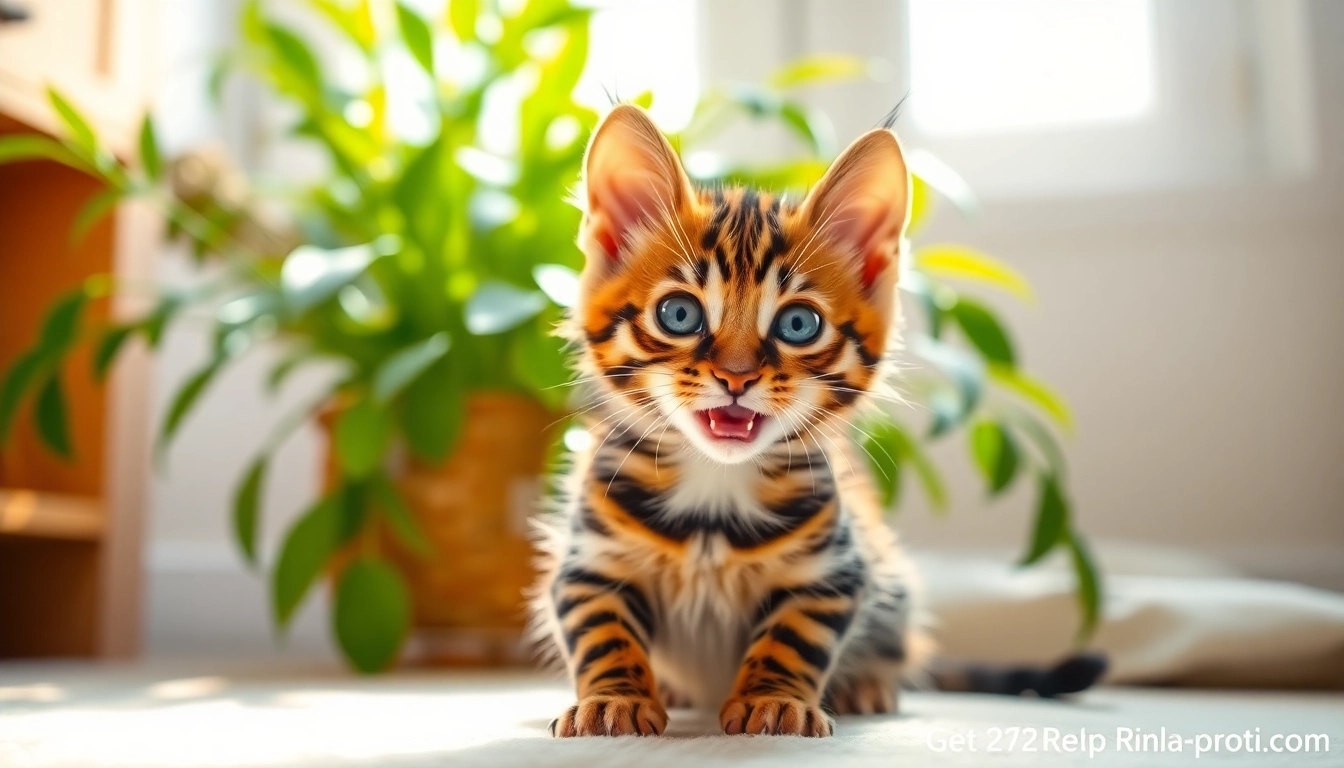Understanding the Bengal Breed
Bengal cats are known for their wild appearance, resembling small leopards or ocelots. This exotic breed has gained immense popularity due to their striking looks and unique personality traits. However, before adopting a Bengal kitten, potential owners need to understand the breed thoroughly, including its history, physical characteristics, and temperament. Knowledge about the registered Bengal breeder is crucial to ensure a healthy and well-socialized pet.
History and Origin of Bengals
The Bengal cat breed was artificially created in the 1970s by crossbreeding domestic cats with the Asian leopard cat (Prionailurus bengalensis). This hybrid breeding aimed to capture the exotic look of wild cats while maintaining the personality of a domestic pet. Jean Mill, a pioneer in the Bengal breeding community, played a significant role in the breed’s development, which was further refined by other breeders over the years.
Initially, Bengals faced skepticism about their temperament and was often categorized as difficult pets. However, as breeders focused on developing friendly and sociable lines, Bengal cats have become beloved companions in many households. They are now recognized by major cat breeding organizations, including The International Cat Association (TICA).
Distinct Features of Bengal Cats
Bengal cats are easily identifiable due to their stunning coat patterns, which can include spots, rosettes, and marbling. Their unique fur is short yet dense, providing a soft touch that is reminiscent of a rich, luxurious pelt. Common color variations include brown spotted, snow, and silver rosetted.
Beyond their beautiful coats, Bengals have a sturdy, muscular build with medium to large size frames. They have large, expressive eyes, a broad nose, and ears that are slightly rounded. Notably, their athleticism makes them agile and playful, often engaging in activities like jumping and climbing.
Common Traits and Temperament
Bengal cats are renowned for their active and playful personalities. They require ample stimulation, both physical and mental, to remain happy. Known for their intelligence, Bengals can often be trained to perform tricks, walk on a leash, and even play interactive games. Their social nature means they thrive in multi-pet households and enjoy interactive playtime with their human companions.
This breed tends to be curious and can exhibit traits reminiscent of their wild ancestry, making secure environments a must to prevent escape attempts. Their vocalizations vary, with many Bengals being more talkative than ordinary cats. Overall, they are affectionate, loyal, and love human interaction, making them ideal companions for families and individuals alike.
What to Look for in a Registered Bengal Breeder
Choosing the right breeder is a critical step in acquiring a healthy Bengal kitten. Responsible breeding practices ensure that the kittens are well-socialized and free from genetic defects. When searching for a registered Bengal breeder, it’s vital to consider several key factors.
Ensuring TICA Registration and Compliance
One of the first steps in selecting a Bengal breeder is to verify their registration with The International Cat Association (TICA) or similar organizations. Registered breeders adhere to established ethical standards and guidelines, which contribute to the overall health and well-being of the breeding stock.
Breeders maintaining TICA registration are typically committed to the breed’s integrity and follow specific breeding practices that promote healthy kittens. Furthermore, they usually provide documentation of pedigree for the kittens, ensuring that prospective owners understand their kitten’s lineage and genetic background.
Health Testing Practices in Bengal Breeding
Health testing is crucial to ensure that both the breeding cats and the kittens are free from hereditary conditions. Responsible breeders will conduct health screenings for common issues associated with Bengal cats, including Hypertrophic Cardiomyopathy (HCM) and other genetic disorders.
Ask prospective breeders about their health testing protocols and ensure they provide documentation of their cats’ health clearances. A good breeder will prioritize the health of their cats and offer guarantees on the health of the kittens, allowing new owners peace of mind regarding the well-being of their new pet.
Reputation and Reviews of Breeders
Researching a breeder’s reputation involves looking for reviews and testimonials from previous buyers. Engaging with online communities or forums focused on Bengal cats can help one gauge the credibility of a breeder. Positive feedback and success stories can indicate that the breeder is responsible and dedicated to producing wonderful pets.
It is also helpful to connect with your local or regional Bengal clubs, which can point you toward reputable breeders and potentially even provide insights into breeders’ past dealings with buyers and their overall satisfaction levels.
How to Evaluate a Potential Breeder
Once you narrow down your search to a few potential breeders, it’s essential to evaluate them carefully to ensure they meet the standards of responsible breeding.
Key Questions to Ask a Bengal Breeder
Before committing to a breeder, prepare a list of questions that touches on various aspects of their breeding practices. Some essential questions to consider include:
- How long have you been breeding Bengal cats?
- What are the breeding goals you aim to achieve?
- Can you share the health testing results for the breeding parents?
- What socialization techniques do you use for your kittens?
- Will I receive a written contract and health guarantee for my kitten?
These questions can provide insight into the breeder’s experience, the health protocols adopted, and their commitment to preserving the quality of the Bengal breed.
Understanding Breeding Ethics and Practices
In addition to asking specific questions, it’s essential to evaluate the overall ethics of the breeding operation. A responsible breeder prioritizes the well-being of their cats and will not overbreed or compromise the integrity of the breed. Ensuring they follow proper ethical practices can lead to healthier and happier kittens.
Look for breeders willing to discuss their practices openly and who demonstrate a passion for maintaining and improving the breed. Those who lack transparency or show signs of operating out of profit motives may not be the right match.
Visiting the Cattery: What to Observe
If possible, arrange to visit the breeder’s cattery. Observing the environment where the kittens are raised can provide excellent insight into the breeder’s practices. Pay attention to the following:
- Is the cattery clean and well-maintained?
- Are the cats well cared for and socialized?
- Do the kittens appear healthy and well-adjusted?
- Are the living conditions spacious and enriched for the cats?
Breeders who are proud of their facilities will typically welcome potential buyers and showcase their operations with transparency.
The Cost of Bengal Kittens from Registered Breeders
The price of Bengal kittens can vary significantly based on several factors, including pedigree, breeder reputation, and location. Understanding these aspects is essential for budgeting for your new feline family member.
Average Prices for Bengal Kittens
On average, Bengal kittens purchased from reputable breeders range from $1,500 to $3,000. Pricing often reflects the kitten’s lineage, with those coming from champion bloodlines likely to be priced higher. Additionally, color variations and pattern types can also affect the price.
For instance, snow Bengals or those with unique rosette patterns may command higher prices due to their rarity and demand among buyers. In contrast, common colorations typically fall into the lower price range.
Factors Affecting the Cost of Bengal Cats
Several factors can influence the overall cost of acquiring a Bengal kitten from a registered breeder. Key factors include:
- Breeder Reputation: Well-established breeders with positive reviews and a strong reputation will typically charge more for their kittens.
- Health Testing: Breeders who invest in comprehensive health testing incur costs that can affect the final price of the kittens.
- Demand and Availability: During high demand periods, prices may rise due to limited availability, making timing essential for potential buyers.
- Location: Pricing can also vary by region, with breeders in urban areas potentially charging more due to higher costs of living.
Long-term Budgeting for Bengal Ownership
Beyond the upfront cost of purchasing a Bengal kitten, potential owners should consider the long-term financial responsibilities associated with the breed. These can include:
- Monthly Care Costs: Food, litter, and routine expenses can accumulate over time.
- Veterinary Care: Regular check-ups, vaccinations, and emergency visits can add up.
- Insurance: Pet health insurance is often recommended as a financial safety net.
- Specialized Equipment: Bengals require toys, climbing structures, and enrichment activities to thrive.
Creating a budget that encompasses both initial and ongoing expenses is essential to ensure you’re prepared for the financial commitment of Bengal ownership.
Bringing Your Bengal Home
After selecting a reputable breeder and bringing home your Bengal kitten, there are important steps you should take to ensure a smooth transition for both you and your new pet.
Preparing Your Home for a Bengal Kitten
Before your Bengal arrives, ensure your home is a safe and welcoming environment. Consider the following preparations:
- Remove hazards such as toxic plants, small objects, or potentially dangerous decor.
- Set up a designated area for your kitten to explore, including a comfortable bed, litter box, and food and water dishes.
- Invest in climbing structures and interactive toys to keep your kitten engaged and active.
- Consider cat-proofing windows and doors to prevent escapes, as Bengals are natural climbers and explorers.
The Adjustment Period for New Bengal Owners
Upon bringing your Bengal home, be prepared for an adjustment period. Kittens may initially feel anxious in their new environment, so it’s essential to provide a warm, calm atmosphere. Gradually introduce them to your home, allowing them to explore at their own pace.
During this time, focus on bonding through gentle play and consistent interaction. Patience is key, as developing trust can take time. Observe their behavior for signs of stress and adapt your approach accordingly.
Resources for Ongoing Support and Care
Pursuing reliable resources for Bengal care can help ensure you’re providing the best environment possible for your new feline. Consider the following avenues for support:
- Bengal Cat Forums: Online communities can be excellent sources of information and support from fellow Bengal owners.
- Veterinary Resources: Find vets with experience treating Bengals and keep an open dialogue about your kitten’s health.
- Books and Guides: Educational materials focused on Bengal care, training, and understanding the breed can be incredibly beneficial.
- Local Cat Shows: Participating in or attending cat shows can provide networking opportunities with breeders and experts in the field.
Building a reliable support network can greatly enhance your experience as a Bengal owner and contribute to the wellbeing of your feline companion. The journey with your Bengal begins with thoughtful preparation, diligent care, and an appreciation of their unique qualities.



